4 Retail Industry Trends We’ll See in 2022
Published on Dec 15, 2021

Though we’ve turned a corner on the tumultuous times in the height of the COVID-19 pandemic, residual impacts continue to burden the retail industry. From labor market and supply chain shortages to global economy challenges and climbing inflation, brands are facing a new set of make-or-break moments in the future of the retail industry.
To succeed, retailers must evolve to meet the heightened demands of today’s employees + customers. Our most recent study on employee and consumer behavior takes a closer look at 4 forward-looking retail industry trends to keep top of mind when planning for 2022—and 4 innovative ways brands can improve the employee experience + customer experience.
Retail industry trend #1: Brands must prioritize the employee experience to compete in today’s challenging labor market
This year’s record-breaking rise in job vacancies is forcing organizations to work even harder to provide appealing opportunities—not only to draw in new candidates but to retain loyal, long-term employees.
Brands must go beyond competitive wages (though money matters, too) to ensure they’re offering different ways for employees to find meaningful work—which means less tedious tasks and more meaningful interactions with customers.
Our research shows, just after healthcare, retail was the top industry for job seekers—listing pay and fulfilling work as the main reasons they’ll stay at, or leave, a retail position.
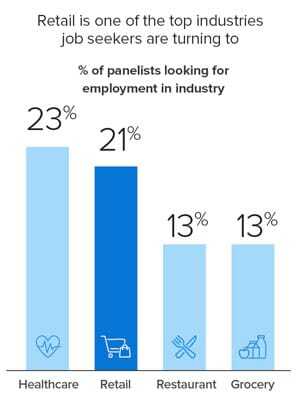
While this is helpful information for retailers, it can be tricky to universally define “meaningful work.” What makes a job fulfilling can differ from employee to employee. It is safe to assume, however, most workers would prefer fewer tedious tasks and more helpful interactions with customers.
The good news is customers want this as well. Our data shows more than half of consumers prefer to use self-checkout—giving brands an opportunity to reallocate labor away from this process and put more staff on the floor to better serve customers.
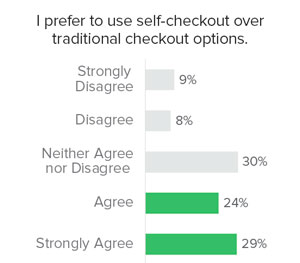
Takeaway: Create jobs that offer personally fulfilling opportunities.
Happy customers start with happy employees. Attract + retain top talent by providing a rewarding work environment that limits (or automates) tedious tasks and aligns with employee expectations.
Retail industry trend #2: As retail supply chain volatility continues to challenge product availability, customers will turn to multiple touchpoints
Empty shelves. Delayed shipping. Canceled orders. Today’s retail supply chain shortages have created a nightmare for the industry—turning potential customers into frustrated non-purchasers. And with retail supply chain issues expected for the foreseeable future, cross-channel shopping will continue to increase as consumers are forced to leverage multiple touchpoints to fulfill their shopping needs.
Our research shows most consumers planned to shop online this holiday season (with more than half opting for at-home delivery). But we’re also seeing a rebound for in-store traffic with an 11%-pt increase from last year.
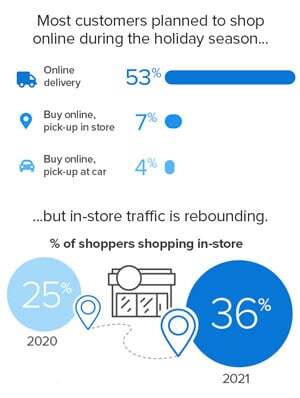
It’s also important to note 47% of in-store shoppers plan to use their phones to access discounts—putting more pressure on brands to ensure their cross-channel strategy is on point. Because when customers have a disjointed shopping experience, they see a disconnected brand.
Takeaway: Execute a consistent cross-channel retail customer experience.
As the customer journey becomes more complex, ensure all touchpoints—from website to in-store and everywhere in between—are in sync and delivering a seamless experience.
Retail industry trend #3: With inflation on the rise, brands must place greater emphasis on quality to drive value perception
As inflation limits how far a dollar can go, shoppers will prioritize value and reconsider which brands to give their business to. But the good news is price isn’t the only factor customers consider—in fact, it’s the quality of a product and service provided that carry more weight with value perception.
Our research shows many consumers’ financial situations have improved since last year. But as prices continue to increase, value remains at the forefront of purchase decisions.
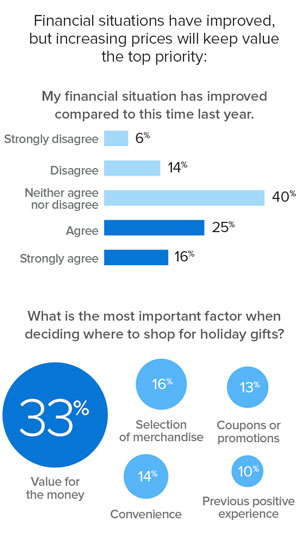
Although it is difficult to say for sure how customers will react to economic factors, it’s almost certain they’ll remain more selective in how they spend their money. Consuming for the sake of low prices may be out, but there will always be a market of consumers seeking satisfying experiences that make their lives more fulfilling. Delivering on these experiences is one way to ensure retailers survive the challenges ahead.
In reality, customer value perceptions are often complex and unreliable. Not only are price perceptions highly variable, they’re based on factors outside of operators’ control. Value does matter for some brands but often the best way to influence value in the long run is to deliver a better customer experience.
Price discounts and promotions can impact value in the short-term and drive consumer spending but even if they are successful in driving short-term traffic, they often do not generate greater customer loyalty. The best way to drive customer loyalty is to deliver a better customer experience at whatever price point your brand occupies.
Takeaway: Provide quality products + service for a differentiated retail customer experience.
When costs go up, so do value expectations. Win customer loyalty by offering stand-out products, delivering exceptional service, and providing transparent communication around pricing.
Retail industry trend #4: Winning brands will focus on sustainability efforts to reduce environmental impact
“Sustainability” isn’t just a buzzword retail businesses can throw around without factoring it in to the customer experience. Today’s consumers are more environmentally conscious and awarding their business and loyalty to organizations putting sustainability initiatives into action.
In fact, 62% of consumers care about the impact their online shopping has on the environment—with the amount of packaging topping their list of concerns. Additionally, our data shows environmental concerns are higher with younger online shoppers.
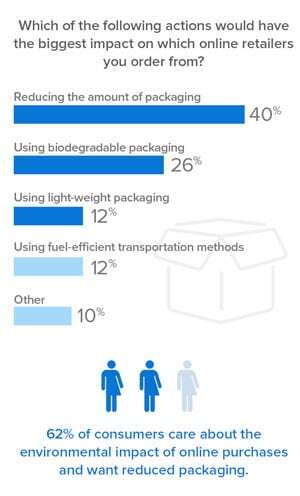
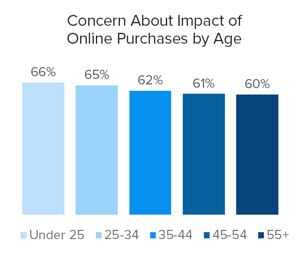
Environmental concerns aren’t exclusive to e-commerce consumers. In-store shoppers are expecting brands to limit (or omit) plastic bag usage, prioritize recycling, and use locally-sourced products. With these expectations, consumers are willing to contribute by providing their own bags—though it’s important to note only 9% said they’d be willing to pay extra for a plastic bag if they forgot.
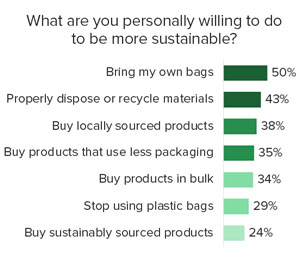
Takeaway: Implement sustainability practices.
Upcycling, package reduction, omitting plastic bags, and local sourcing will have a big impact on customers—especially younger consumers, whose buying share will continue to increase.
Transform retail customer experience feedback into business-changing action
The unprecedented ups and downs of the past two years have made it difficult to prepare or predict what’s coming in 2022. But we do know the most effective way to weather the storm is to leverage the direct feedback of employees + customers. Brands that can adapt their experience management (XM) strategies to meet changing needs and expectations will be the ones to come out on top.
To help guide your employee + customer experience strategies as we move into the new year, download the report: 4 retail industry trends we’ll see in 2022.
Related articles

4 Restaurant Industry Trends We'll See in 2022 and What to Do
Restaurant industry trends took a turn during the pandemic and many changes are here to stay. Here are our predictions for the upcoming year.

Optimize your digital experience management strategy
Here are the 3 most common pitfalls we help clients avoid while prioritizing their digital experience management (XM) strategies...

How Brands Can Attract and Retain Employees in 2022
Labor shortages have made staffing difficult. Here's what workers are looking for and how brands can attract and retain talent.